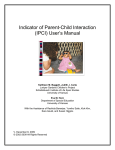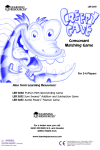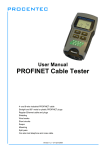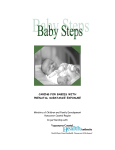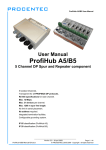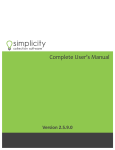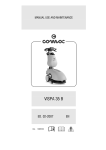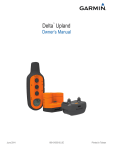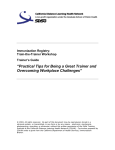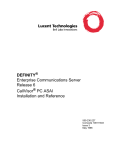Download Indicator of Parent-Child Interaction (IPCI) User`s Manual
Transcript
Indicator of Parent-Child Interaction (IPCI) User’s Manual Kathleen M. Baggett, Judith J. Carta Juniper Gardens Children’s Project Schiefelbusch Institute of Life Span Studies University of Kansas Eva M. Horn Department of Special Education University of Kansas With the Assistance of Rashida Banerjee, Yumiko Saito, Kiok Kim © 2002-2003 All Rights Reserved; Format Version September, 25, 2006 Baggett, Carta, & Horn Table of Contents _____________________________________ Introduction…………………………………………………………………………………3 IPCI Administration……………………………………………………………………….6 Interaction Activities……….……………………………………………………..6 Materials……………………………………………………………………………...6 Pre-Assessment Visit Introduction for Parents or Other Caregiver....8 Administration Instructions………………………… .………………………..9 Administration Tips……………………………………..………………………15 Administration Questions and Answers...….……………………………..18 Item Definitions and Scoring………………………………………………………..23 Overview of IPCI Items…………………………………………………………..23 General Scoring Procedures…………………………………………………….24 Parental Caregiver Domains…………………………………………….25 Child Domains………………………………………………………………38 Appendices……………………………….………………………………………………41 IPCI Rating Cover Sheet IPCI Rating Sheet Inter-rater Agreement Worksheet 2 Introduction ______________________________________________ Why Another Measure for Assessing Parent-Child Interaction? Parental caregiver-child interaction is the earliest and foremost mechanism for promoting positive social-emotional behavior in very young children. While infant mental health theory, evidence-based practices for supporting positive behavior in young children, and routines-based intervention in early childhood all emphasize the importance of parent-child interaction in promoting children’s early social-emotional behavior, few assessment tools exist for assisting practitioners in efficiently screening at-risk parent-child interactions and monitoring progress expected with intervention. This gap is illustrated by a host of limitations of more commonly available measures, which include administration requirements beyond the training and experience of most early intervention service providers, measures that are too long and complicated for repeated use in authentic environments such as homes and child care settings, and lack of readily available reports that can show progress toward important outcomes. To advance effective practice for supporting early parental caregiver-child interaction and young children’s early social-emotional development, specific characteristics of parent-child interaction measures are needed. That is, to be useful for practitioners providing early intervention services, measures need to meet the following criteria: They need to focus on key parent and child behaviors that signal or indicate quality of parent-child interaction and that are predictive of social-emotional outcomes in young children They need to focus on behaviors that occur in the context of natural settings where parents/caregivers and children typically interact without the requirement of videotaping They need to be easy to administer for individuals across multiple disciplines with various levels of training (e.g., Part C early intervention staff, Early Head Start staff, social workers, counselors, and nurses). They need to be suitable for quick and frequently repeated administration What is the Indicator of Parent-Child Interaction (IPCI)? The Indicator of Parent-Child Interaction (IPCI) is an Individual Growth and Development Indicator. It is a means of checking growth toward the important general outcome of interactions in which parents and other primary caregivers respond to their child in ways that promote positive social-emotional 3 behaviors. This General Outcome is directly related to social-emotional competence, another highly accepted and valued General Outcome in early childhood. Performance is measured through repeated assessment of the same key skills using the same set of care-giving activities and scoring procedure. Unique features of the IPCI as compared to common limitations of many existing approaches include the following: (1) focus is on key parent and child behaviors that signal or indicate quality of parent-child interaction and that are predictive of social-emotional outcomes in young children, (2) focus is on activities that typically occur in authentic environments where parental caregivers and very young children interact such as in homes with parents or other caregivers or in child care settings, (3) it can be administered within 10 minutes by a variety of practitioners that typically provide early intervention services (e.g., Part C Early Intervention staff, Early Head Start staff, nurses, counselors, and social workers), (4) it is designed for frequently repeated administration in family homes or center-based settings; and (5) reports can be generated automatically to guide intervention decision-making. What populations has the IPCI been used with? The IPCI is designed for use with children between the ages of 2 and 42 months. It has been used with children in this age range across several federally funded research studies including both descriptive and intervention studies. Families participating in studies with the IPCI were referred from a variety of agencies including urban and rural Early Head Start programs, alternative school programs for teen-aged parents, and inner urban WIC clinics and prenatal clinics. Families were culturally and linguistically diverse and many were experiencing multiple risks including the following: • Teenage parent status • Children with or at-risk for disabilities • Extreme poverty • Undocumented citizen status • Functional homelessness • Very low parent education level • Parents at risk for child maltreatment • Maternal depression and/or anxiety • Families with histories of substance disorders and domestic partner abuse What are the qualifications for IPCI administration and scoring? Any early childhood service provider may administer and score the IPCI after completing administration and scoring certification. 4 How can IPCI results be used? IPCI reports can be automatically generated from the IGDI website to provide information about both parental caregiver and child behavior. These reports are designed to be used in conjunction with other assessment data to guide intervention decision-making. The IPCI can be repeated as often as monthly for progress monitoring. Parent Facilitator and Child Engagement domain reports can be interpreted by and shared with parents by an early childhood service provider who is certified on administration and scoring. When should behavioral/mental health consultation be sought? Parent Interrupter and Child Distress domain reports are designed to be used with mental health consultation to understand specific interaction challenges that a parent and child may be facing. When scores in these domains (i.e., Parent Interrupters and Child Distress) fall in to the concern range, mental health consultation should be sought for guidance in intervention decisionmaking and planning. 5 IPCI Administration ______________________________________________ IPCI Interaction Activities The Indicator of Parent-Child Interaction is completed following a series of brief interaction activities between a parent (or other primary caregiver) and their young child at home or in a child care setting during a 10-minute observation period. IPCI activities include the following: • Free Play • Book Activity • Distraction Task (*Only for children older than 1 year of age) • Dressing IPCI Administration Materials The IPCI materials kit includes the following: • Small carry case for all materials • Blanket/plastic top table cloth (at least 5’ X 7’) • Set of brightly colored keys and key ring attached to recorder • Books (Brown Bear, Touch and Feel Puppy, Fiesta; Available in English, Spanish and Braille) • IPCI Administration Protocol • IPCI Rating Sheet • Timer (Be sure time signal is soft and subtle. Do not use timer with a loud or repetitive buzzer) • Camcorder, tripod, videotape or memory stick (if rating sheet can not be completed live) • Video recording device (for clinical use of video reflection) IPCI Administration Steps Step 1: Cover the Pre-Assessment Visit Introduction for Parents or Other Caregivers. The Pre-Assessment Visit Introduction for Parents should be discussed with parental caregivers prior to the assessment visit (either during a home visit that precedes the assessment visit or by telephone). It should also be reviewed again with the parent at the time of the assessment. Step 2: Follow Administration Instructions. Step 3: Be familiar with and prepared to use IPCI Assessment Tips for establishing rapport, managing possible disruptions, responding to parent and/or child discomfort, and facilitating smooth activity transitions and positive closure. 6 Pre-Assessment Visit Introduction for Parents The ways in which young children interact with their parents (or other important caregivers) can be very different for individual children. There are also many different types of activities that young children do with their parental caregivers such as eating, bathing, dressing, and playing. To better understand how your child is relating at home (or at child care center) with the most important adult/s in their lives, I would like to spend some time observing some important and common activities for very young children. These include: (1) (2) (3) (4) Whatever you and your child enjoy doing together Looking at books Seeing how your child handles frustration (if he/she is over 1 year old) Dressing (putting on shoes, socks, and shirt) Getting Ready for the visit: There are a few things that you can do to help the visit go smoothly and to learn the most about how your child is relating. These include preparing your child for the visit, letting others know that you will be busy during the visit, and having anything on hand that you would like. • Preparing your Child: You can help your child to be ready for the visit by making sure that he or she has eaten recently and is rested. Please feel free to help your child feel as comfortable as possible. If your child gets fussy, please feel free to do whatever you would normally do to help your child feel comfortable. We are not interested in you or your child ‘putting on a show’. Instead, we (you and I) can learn best about how your child is relating by seeing what happens the way you usually interact togetherwhatever it is that you and your child would normally do. • Letting others know that You will be Busy: It will help the visit go more smoothly if you let family and friends know that you will be busy during the time of the visit. It is best to schedule a visit at a time when you think you won’t be interrupted by visitors or phone calls. • Things to have on hand: While it’s not necessary for you to have materials or toys available, if there are any things that you and your child especially enjoy doing together, it would be good to have any such materials out and ready. For the dressing activity, you may either take off and replace your child’s shoes, socks, and shirt or if you wish to put on another set of clothes, it would be good to have these ready at the time of the visit.” IPCI Administration Instructions 7 After establishing rapport and reviewing the Pre-Assessment Visit Introduction for Parents, the IPCI may be administered. The assessor should be thoroughly familiar with them prior to administration and should reference them while maintaining eye contact with the parental caregiver. Avoid giving the appearance of ‘reading’ the instructions. The activities should be presented in the order that they occur in the protocol. Always begin with Free Play and never end with the Distraction task. While the IPCI is designed to be used for guiding intervention decision-making, intervention is a separate activity from assessment and should not enter into play during assessment. Reliable and valid results depend on following the administration protocol and making individual accommodations as recommended for increasing parent and child comfort when warranted. Always follow the instructions and use IPCI Administration Tips for making appropriate individual accommodations. Pay close attention to the verbal and nonverbal messages that you send during the observation. Focus on maintaining a relaxed and accepting stance. It is appropriate to provide general encouragements and reminders about what is expected. However, it’s important to avoid intervening during the observation by sending verbal or nonverbal messages of approval, disapproval or behavioral expectations about what the parent or child should be doing. Unless the child is at-risk of injury during the assessment, do not intervene. 8 Free Play • Materials: No materials are required for this activity. • Setting up: Remember to set the timer for 4 minutes as soon as you give the instructions below. • Instructions: o “Let’s get started by spending a few minutes with you and your child doing something together that you enjoy. o This activity should be something that you and your child are both comfortable with and used to and something that your child loves to do. o Please feel free to move around as is comfortable for you and your child. You don’t have to sit in one place, but I’ll need to know what room you’d like to be in so that I can move along with you. o Sometimes parents talk or play games without toys, sometimes parents just sit with their children, and sometimes children like to play with a favorite toy. o Whatever you and (child’s name) normally do that makes (child’s name) smile, laugh, or have fun is what I want to see. Feel free to stay with an activity or change activities as you would like. Attend to any needs your child might have during this time just as you normally would.” • Note: The purpose of this activity is to be as non-restrictive as possible and to encourage the parent and child to engage in whatever activity they enjoy. It is important not to impose any structure on the parent above and beyond the instructions. Therefore, do not restrict the parent’s and child’s movement by asking them to stay in one place. Instead, encourage the parent to let you know if they would like to move simply so that you can stay with them. If the parent looks toward you during the assessment or engages in behavior that suggests s/he is concerned with being in view of the camera or needing to ‘look good for the camera’ (e.g., pulling child’s arm in an attempt to position child in front of camera or saying ‘stay here so they can see you’ to the child, remind the parent that is your job to move the camera around and that you need mom and child to do whatever they would like without worrying about the camera at all and to ignore the camera as much as possible. 9 Looking at Books • Materials: Books (Brown Bear; Touch and Feel Puppy) • Setting up: Give the books to the parent. Remember to set the timer for 2 minutes as soon as you give the instructions below. • Instructions: o “During the next few minutes, you and your child can spend a few minutes with these books. o However you want to use the books with your child is fine. o Feel free to attend to whatever needs your child might have during this time.” • Note: Do Not ask the parental caregiver to ‘read’ to his or her child. This is very important for at least two reasons. First, parents who can not read or who are self conscious about their reading ability, may shy away from interacting with their child because of the instruction to ‘read’. Second, some parents will interpret the instruction to ‘read’ literally and will do so regardless of whatever conflicting signals for readiness the child might show. While this may happen spontaneously, the instructions were designed to avoid stimulating such an effect. If the parent gives verbal or nonverbal cues of discomfort with the task or tells you that s/he can’t read, encourage the parent that however s/he would like to use these books with the child is just fine and that you’re really interested in the interaction with books- not necessarily in reading. If the parental caregiver appears uncomfortable and looks to you for support or confirmation as to what is expected, paraphrase instructions and maintain a supportive stance, but do not make any specific behavioral suggestions to the parent. 10 Distraction Task • Materials: Blanket/table cloth and recorder with tunes and key chain • Setting up: Lay down the blanket. Then, give the instructions. As soon as the instructions have been given, turn the recorder on and set it on the blanket in front of and within reach of the child. Remember to set the timer for 2 minutes as soon as parent and child are on the blanket and the recorder has been placed on the blanket and turned on. Special Accommodation: if the parent has a physical disability making it difficult or impossible to get down on the floor, this activity can be set up by placing the recorder and keys on the couch within reach of the child and asking the parent and child to stay on a couch rather than a blanket. • Instructions: o “Sometimes there are materials around that are either dangerous (like electrical outlets) or that may not necessarily be unsafe for children but that are important for children not to play with because they are breakable or otherwise not appropriate for a young child. o For a few minutes, we would like for you to keep (child’s name) on this blanket and not allow him or her to get this recorder. o Normally, we would never intentionally place something in front of your child that s/he can not have but because there are times when such materials may be unavoidable for your child, such as in the car, grocery store, or at the doctor’s office, it’s important to see how your child handles such situations- when there is something in reach that is not appropriate to have. • Note: It is fine for the parent to engage the child with any materials so long as the Parent introduces the materials. Do not make any suggestions or give the parent alternate materials with which to engage the child. If this activity is particularly stressful for the child or parent, be prepared to help the parent and child calm at the end of this activity before moving on to the final activity. Be empathetic and reflect that this was a difficult task and praise the parent for making it through. 11 Dressing Task • Materials: No materials required if the parent wishes to take clothes off and put them back on (shirt, socks, and shoes). If parent wishes to put on a change of clothes, that’s fine too. • Setting up: Remember to set the timer for 2 minutes as soon as parent and child are on the blanket and the recorder has been placed on the blanket and turned on. • Instructions: o “Let’s spend a few minutes now seeing what it’s like to get (child’s name) dressed in the morning with whatever clothes and/or changing routine you use. o Let’s focus on changing shirt, socks, and shoes or a diaper if that’s needed. It’s fine to simply remove and then replace the same clothing or if you’d like to use a change of clothes, that’s fine too. o However you two normally go about dressing is what I’m interested in.” • Note: After the final activity, dressing, end on a positive note. Point out something positive that you observed during the observation. If something positive was captured on video, replaying a brief section to point out the positive and encourage the parent’s reflection can be helpful. If the activities were particularly difficult or stressful for the parent or child, acknowledge that and empathize with the parent. If the child is distressed, ask the parent what s/he thinks might help to soothe the child. If appropriate, explore basic needs (diaper change if this wasn’t done during the session, bottle, food, rest, activity that child especially enjoys, etc.). In rare cases the dressing task, particularly with a young infant, may not last for 2 minutes, which is fine. Simply note the time on the rating on the rating form. 12 IPCI Assessment Tips There are a variety of things that assessors can do to help ensure that IPCI results are reliable and valid. These include: • Setting the stage for administration • Careful attention to following the administration protocol • Fostering smooth transitions between activities Set the Stage for Administration Setting the stage for administration involves establishing rapport with the parental caregiver, helping the parental caregiver to understand the purpose of the IPCI and what to expect, and helping the parental caregiver to feel as comfortable as possible with video recording. Establish rapport by spending a few minutes (e.g., 5-10) at the beginning of the visit with the parent and help the parent to feel at ease. Prepare parental caregiver for what to expect by reviewing the Pre-Assessment Visit Introduction with the parent. Answer any questions or address misperceptions that the parent may have about the IPCI assessment activities. Help the parental caregiver to feel as comfortable as possible with the video recording process. It’s important that the assessor be as comfortable as possible with the video-recording process so as not to contribute to any discomfort of the parent. If the parent appears uncomfortable or expresses concern about video recording, provide gentle reassurance, explore the parent’s concerns and address them. In most cases, reassurance can be provided to address concerns to permit video recording. Discomfort may arise for various reasons such as concern about who will have access to the video, how the video will be used, unrealistic expectations about the video recording process, or a cultural belief that video recording will cause harm to those who are recorded. Try to identify the concerns and address them. Below is a list of possible concerns and considerations for responding to them. Possible concern: Who will have access to the video? Remind the parent that the video will be kept confidential. Videos also make great gifts and can be given to the parent when the child matriculates from the program. Possible concern: How will the video be used? If the videos will be used for intervention purposes, explain that you will watch the video together with the parent and that it will be used an important tool for you and the parent to understand more about how the child is a relating at home. 13 Misconceptions about the video process or expectations? It’s important to correct misconceptions or unrealistic expectations about the video recording process. For example, some parents envision a big camera or bright lights. They may envision a ‘movie shoot’ or having pictures taken for a family portrait. In such cases, show the camera to the parent. Remind them that this video is very different from ‘staged’ videos or pictures. Instead, we are only interested in usual activities. This is not about dressing up or looking a particular way. Again, what’s important is parent and child comfort. In taping hundreds of IPCI assessments with culturally diverse and many high risk families, less than 1% of parents were unwilling to be video recorded after discussing their specific concerns. In one case, the parent was diagnosed with paranoid schizophrenia and had stopped taking her medication. In the other case, the parent had a disfiguring skin disorder and had removed mirrors from her home. In such extreme and rare cases when video recording can not be done, IPCI activities can be scored live. A significant disadvantage is that video can not then be used for providing positive support interventions. In addition to preparing parents for video recording by exploring and addressing concerns, it is also important to watch for excessive parent or child reactivity to video recording. Signs of reactivity in children will be obvious and may include staring into the camera or coming to look into the camera. Watch for these signs and if you see them, encourage child to return to interaction with parent. If these behaviors are very brief and the child quickly returns to interaction with the parent, then continue to record and make a note on the Rating Cover Sheet about the approximate duration of the reactivity and how it may have affected the assessment if relevant. However, if the child is not quickly redirected to the parent, stop recording and stand in front of the camera. Let the parent know that when the child becomes less interested in the camera, you’ll continue with the next activity. Wait and attend to another activity and minimize interaction with the child. Signs of reactivity on the parent may be more subtle and may include behaviors such as looking into the camera, instructing the child to ‘behave’ or perform for the camera. If you see these behaviors, remind the parent that you are interested in what is usual for parent and child- not putting on a show for the camera. If you anticipate or observe reactivity that is not minimized by the approaches above, be prepared to bring the video camera to visits and turn it on briefly over a session or two to help desensitize parent and child to the video camera. Generally after several opportunities for recording, sensitivity decreases. If you see signs of reactivity be sure to record these on the Rating Cover Sheet and note their effect on the assessment. 14 Attend Carefully to Administration Instructions and Modify ONLY when Warranted. If you are creating a video for certification review, begin video recording just before reviewing the Pre-Visit Introduction for Parents and continuing video recording until the IPCI administration is completed. Introduce each activity by using the protocol script provided in this manual. Present activities in the listed order and do not modify the instructions, initially. If there is any concern about the parent’s understanding of the instructions, ask the parent to paraphrase them. Clarify any misperceptions by simplifying the instructions and/or reminding the parental caregiver about what to expect. Do not tell parents the time limit for each activity. It is important that the parent does not feel rushed, but that the assessor manages time well and helps the parent transition smoothly from one activity to the next. If parents ask about the time, let them know that it will just be a few minutes and that you’ll let them know when it’s time for the next activity. As soon as the parent initiates the designated activity, set the timer for the allotted time (e.g., Free Play- 4 minutes; Book Activity- 2 minutes; Distraction Task- 2 minutes; and Dressing- 2 minutes). Foster Smooth Activity Transitions • Be sure to select a timer that signals time in a subtle manner. Avoid loud or distracting buzzers or other distracting sounds. • Remember, the timer is for the assessor, not the parent and child. The role of the assessor is to facilitate smooth transitions from one activity to the next. • Avoid abrupt transitions and use care to avoid disrupting the parent and child when the timer signals the end of an activity. Instead, if the parent and child are engaged in activity, pause and watch for a moment to create a break by walking slowly toward the parent and child commenting on the activity just completed, orienting the parent to the next activity (e.g., use previewing—Let’s see if (child’s name) is ready to look at a book), and introducing the activity. 15 Common IPCI Administration Questions and Answers 1. If the family has 2 children, do we need 2 separate IPCI sessions? a. Yes. Also, if siblings are around and in the video for the target child, only score parent behavior directed toward the target child except in the case where a negative or harsh voice-tone is directed to another child and the target child is exposed by virtue of proximity. 2. What if the family is very resistant to being video taped? Can you score in session? a. Remind the parent that the video is only to help the assessor and parent be able to learn together about how the child is relating to others at home. Also, if the assessor is nervous or embarrassed about videoing, the family will be. Advocates must be comfortable with the procedure. b. Often, if the video recording is started early and the assessor provides a brief, appropriate explanation, parent’s apprehensions can be alleviated and families will get used to the recorder and ignore it. c. If the parent/caregiver continues to express reservations, find out exactly what the parent is concerned about and help to alleviate the worry. For example, some parents are concerned that individuals other than the assessor might see the video. Others have misperceptions about what it will be like to be videotaped and expect lots of lights and a big camera such as an in a photo shoot. In this case, parents can be shown the equipment and can be encouraged to do whatever they normally do and how things normally go- this is not about putting on a show. In other cases parents have initial discomfort with the assessor being across the room with the camera. In this case the camera can be set up with the parent and child in the shot and then sit down beside the parent and let her know that you’ll “start out together on the video”. Let her know that you will need to check the camera but you’ll stay with her at the beginning. 3. Can we score live instead of from videotape? a. Scoring live requires the assessor to be certified in scoring live before this method can be used with families. Becoming a certified scorer during live observation is more difficult than scoring afterward because the same person must both administer and score the IPCI while managing other challenges or distractions that may occur in the home. 16 b. There are pros and cons that should be weighed carefully in making the decision about whether or not to videotape. Below are a list of pros and cons of videotaping. Our experience has been that videotaping is preferable to live scoring in a variety of ways. Pros Cons (2) Video can be a powerful intervention tool for supporting positive interaction and providing concrete examples of parent and child growth. (2) Staff must be trained in sensitive use of video w/ families to help families become more comfortable with video. (3) Video also offers advantages in reflective supervision, allowing for home visitors to receive concrete support in intervention planning. (3) Staff will have to spend some time upfront. (1) Staff don’t have to be certified as a scorer at the time of administration. (1) Video equipment must be purchased if not on hand (4) Videos returned to families as home movies at the end of the program make a a wonderful gift. 4. What if the parent just doesn’t want to do the assessment? a. Strongly encourage them as it is a normal (if new) part of the EHS protocol and does not require extra commitment on their part. b. Remind the parent that the assessment can provide important information to the home visitor and the parent about how the child is relating at home. This is an opportunity to learn together. 5. (a) It seems like the parent sections focus on the negative. (b) Is this judging the parent? (a) Actually, the IPCI focuses on parent behaviors that are known to support more positive child outcomes. This includes high rates of facilitative behaviors as well as low rates of interrupting behaviors. Low scores on interrupting behaviors are a good thing. (b) Practitioners need to be aware of both strengths and concerns if they are going to partner with parents to build on strengths in a meaningful way. We know that the purpose of assessment of children in early intervention should never be to ‘judge’ them. Rather, it is often to identify areas of strengths or concerns that warrant intervention for addressing real needs and improving quality of life or for determining if intervention is working as intended for the child. 17 Interactions with parents and other primary caregivers are of critical importance in the lives of very young children. There is strong evidence that the quality of parent responsiveness is linked to important outcomes not only in early childhood but throughout the life span. Parent-child interactions are especially critical to early social-emotional development. Through daily interactions, there are opportunities for parents to either directly support positive child social-emotional behavior and development or to engage in behaviors, sometimes completely unaware, that either fail to support or actually interfere with positive socialemotional skills. In order to effectively support children’s social-emotional development, we need quick, reliable and valid tools for assessing the role of parentchild interaction so that we can tell when interactions are risky and provide early support to help interactions get back on track before problems mount and become entrenched. Using an indicator of parent child interaction can provide valuable information about where concrete strengths exist so that they can be celebrated with and encouraged in parents. Such an indicator can also point out specific skill areas that need to be supported. In this way, information about skills that are off-track can highlight where support is needed and information about specific strengths can be used as a starting point to highlight existing skills and then begin building new skills. 6. How often should the IPCI be done? a. Every 3 months for regular monitoring. b. During the intervention phase, more frequent monitoring (monthly or less) would be appropriate if a possible concern is identified. 7. Can you do the different tasks on different days for a single IPCI administration? a. It is important to complete the activities at one time because this gives the best overall picture of parent-child interaction at a particular point in time. When it is explained to the parent up front that all tasks take less than 15 minutes and parents have been prepared for the assessment through discussion about possible distractions and how these can be minimized, it is very unlikely that it will not be possible to complete the entire assessment. This is especially true if the home visitor introduces and conducts the assessment at the beginning of the meeting. In over 350 observations with high risk families, it has only been necessary to end the assessment prematurely and to re-do it on another day in one or two cases. If the assessment must be stopped for some 18 reason and it was not possible to observe each activity, the assessment should be rescheduled for another day. 8. Do we pause the camera if the baby’s diaper is being changed? a. The key here is to make sure the child’s privacy is protected. Rather than pause the camera, it is much better to shift the camera to focus on the parent and any unexposed area of the child.. This can usually be done quite easily by lifting the lens so that the child’s exposed area is not in the picture. This is far preferable to pausing the camera, because it then allows the assessor and the parent to see what the parent is doing and how the child is responding, which can be very important for intervention purposes should intervention be warranted. 9. What about personal and cultural differences? a. Being sensitive to and aware of cultural differences is always best practice. Parents may play with their child in many different ways. There is no prejudgment about the types of activities they may choose to engage in with their children (e.g., social play, materials play, etc.). However, the IPCI focuses on specific behaviors that are associated with either more positive child outcomes or more negative child outcomes regardless of the child’s cultural background. b. Scores should be scored based solely on the video tape and with careful attention to the behavioral definition , not what you know about the family. This should not result in parent-child interactions looking “worse” than they are. Rather, you are simply recording what is occurring in the present moment, which is likely to result in the most accurate picture at that particular time. 10. What about parents and children with disabilities? Vision/hearing impairments? Using sign language? What about reading- illiteracy? c. Remember, instructions for the book activity do not involve asking the parent to read to the child. For parents or children with visual impairments, books are also available in Braille, which will help with visually disabled parents and children. 19 Overview of IPCI Items Parental Caregiver (P/C) Domains P/C Facilitators (1) Conveys acceptance/warmth (2) Uses descriptive language (3) Follows child’s lead (4) Introduces voice/materials to maintain or extend child’s interest (5) Uses stress reducing strategies P/C Interrupters (1) Uses criticism, harsh voice (2) Uses restrictions, intrusions (3) Rejects child’s bid for support Child (Ch) Domains (Ch) Engagement (1) Gives positive feedback (2) Shows sustained engagement (3) Follows through (Ch) Distress (1) Overwhelmed by negative affect (fussing, crying, whining) (2) Externalizing distress (3) Frozen, watchful, withdrawn 20 General Scoring Procedures _____________________________________ Immediately following a live or video-recorded administration of IPCI interaction activities, the IPCI rating sheet (including the Cover Sheet) is completed. Each item is rated on a 4-point scale of relative frequency [i.e., 0 = Never; 1 = Rarely (Mild); 2= Sometimes/Inconsistent; and 3 = Often/Consistently (Severe)]. Parental Caregiver Interrupters and Child Distress are rated with regard to relative frequency as well as severity. If there is a discrepancy between relative frequency and severity, then the highest number possible is assigned. For example, if a Parental Caregiver Interrupter occurs once but is severe as specified in the item definition, then a rating of ‘3’ [Often/Consistently (Severe)] is assigned. If a Child Distress behavior occurs frequently but is mild in nature, a rating ‘3’ is assigned. To enhance and maintain inter-rater reliability, the IPCI item definitions in this manual should always be referenced when scoring. While the rating sheet includes brief item labels, complete definitions are provided in the manual. For each IPCI item, a definition is provided, examples and non-examples are presented, and a scoring hint is included. To maximize rating accuracy, it is helpful to use tally marks on the rating sheet next to each IPCI item when an IPCI item example is observed. Criteria for obtaining IPCI scoring certification includes 2 consecutive IPCI sessions, each scored to at least an 80% criteria overall with neither the Parental Caregiver nor Child sub-domains below 70%. Once certification is obtained, inter-rater reliability should be checked periodically to maintain reliability. 21 Item Definitions and Scoring Parental Caregiver (P/C) Domains P/C Facilitators 1. Conveys Acceptance and Warmth The adult conveys acceptance and warmth through approval in one of the following ways: Smiling at the child Making a positive comment to or about the child Providing gentle, affectionate touch. Agreeing with something the child has said Indicating that the child's behavior is correct Confirming what the child has just said Thanking the child for something Stating the child made a good effort, even if the task was not performed correctly Watch for clear and appropriate signals of acceptance and warmth. If a parent gives a verbal and nonverbal message simultaneously, these messages must match and be positive to be an example of this item. A positive comment with a flat expression, frowning, or using negative voice tone is not an example of Conveying acceptance and warmth. A negative comment while smiling or laughing is also not an example of conveying acceptance and warmth. Smiling or laughing inappropriately (such as when a child is hurt, upset, engaging in unsafe behavior or in a behavior that is not appropriate) is not an example of conveying acceptance/warmth. Simply holding or touching a child in the context of a general routine does not necessarily convey acceptance or warmth and therefore is not be an example of this item. Examples of Shows Acceptance and Warmth: Mom smiles as she says ‘Good job, you did it all by yourself!’ 22 Grandma smiles and in a happy, excited voice tone says ‘Oh, those are soft touches to that furry doggie. Dad giggles and says ‘Wow, look at you go!’ as child begins to crawl or walk. Non-Examples of Shows Acceptance and Warmth: Mom says ‘Yeah, you finally did it!’ in a flat voice tone as she rolls her eyes. The child becomes frustrated during play and mom laughs. Child throws a toy across the room and dad smile and then says ‘how many times have I told you not to do that?’. Scoring Hint: While you are observing, make a tally mark on the rating sheet near Conveys acceptance warmth each time you observe an example that meets the definition above. When you are ready to rate this item after the observation, count the number of tally marks you have made and consider these before rating this item. 23 2. Uses Descriptive Language This item includes adult descriptive comments that meet at least one of the following criteria: The comment both labels and connects objects and actions (“the wheels go round”—not “there they go- see what the wheels do”). The comment labels and connects nouns and adjectives (there’s that furry, brown bear). The adult describes activities, objects and/or child’s behavior or feelings. This item does not refer to negative descriptive statements about the child or child’s behavior (e.g., “That’s mean, Don’t be a bad boy, You’re going to hurt yourself”, etc.). During the book activity, this item should be rated based on the parent’s use of descriptive language and imitation or expanding on the child’s interests and vocalizations. Simply reading, without any other descriptive comments to the child, is not an example of descriptive language. Keep in mind that it is possible for adults to talk a lot but not use descriptive language. This is sometimes referred to as ‘impoverished talk’. Simply making sounds, repeating words, making brief statements that do not describe are not examples of Descriptive Language. Simply naming colors, counting, or naming off objects in a room are not examples of Descriptive Language. Examples of Uses Descriptive Language: Child points to a dog and mom says, ‘Yes, that’s a doggie.’ ‘You see the brown doggie.’ Child reaches for a cup and dad says, ‘You want a drink from your sippie cup?’ Child is looking at a book and auntie says ‘You see the duck’. ‘The duck says ‘quack, quack’. Non-Examples See it; Do it Say one Put it there; That one; 24 The orange one; ‘Say, red’ Scoring Hint: During the observation, use tally marks or write down key words next to Descriptive Language on the rating sheet each time you hear an example. It is helpful to write a key word the first time you hear an example. If descriptive language is infrequent, then continue to write key words. If it is frequent, use tallies. Before you assign a rating, count these examples. 25 3. Follows Child Lead The adult follows the child’s lead by noticing what the child is interested in and either commenting on the child’s interest or joining in the same activity without interrupting the child. However, the parent does not interrupt the child or redirect child’s behavior. Following a child’s lead can occur in the context of routines in which a parent may be taking a more active role than in play. For example, a parent who notices and comments on the child’s focus and what is happening during dressing can be an indicator that the parent is following the child’s lead. However, this must be done in a non-intrusive manner to be exemplary of this item. The adult may introduce activity and make suggestions, but parent follows child’s lead through attending, imitating, joining, turn-taking, and/or commenting appropriately on child’s interest. The caregiver may use gestures, words, or actions, consistent with child’s focus, which may slightly extend child’s verbal or nonverbal behavior. The parent may comment on what the child is doing (If the comment is descriptive, it would also be an example of Using Descriptive Language. If in addition, the comment is positive and affirming of the child, it would also be an example of Acceptance/Warmth. Examples of Follows Child’s Lead: Child points to a dog and mom says, ‘Yes, you see the doggie.’ Child reaches for toy phone and dad says, ‘You want to talk on the phone?’ as he pulls it closer to child. Child is tapping a large ring toy and the parent picks up another ring and says ‘tap, tap, tap’ as she taps her ring on the table. Child puts a toy phone up to her mouth and mom says ‘You like that phone’. Mom gets out a book to show child but child is not interested and turns toward another book. Mom says, ‘Oh, you want to look at that one’ as she pulls the book closer for the child. She then says, ‘Let’s read this one’. Non-Examples: The child is looking at or reaching for a toy ring and the adult places another toy in front of the child. The child reaches for a toy and mom begins talking about or pointing to another toy. 26 The child shows interest in a ball by squealing and gesturing for it, the caregiver does not respond in any way. Scoring Hint: During the observation, use tally marks or write down key words next to Follows Lead on the rating sheet each time you hear an example. It is helpful to write a key word the first time you see an example. If following the child’s lead is infrequent, then continue to write key words. If it is frequent, use tallies. Before you assign a rating, count these examples. Remember, in order to score this item as a ‘3’, the adult must have consistently followed the child’s lead without contrary examples in which s/he interrupted the child or missed multiple opportunities to follow the child’s lead. If the parent followed the child’s lead closer to half the time, score a ‘2’, if not, score a ‘1’. Following Child’s Lead is a higher order skill than simply avoiding Intrusions and Restrictions. Always consider Intrusions/Restrictions before rating Follows Child’s Lead. Restrictions and Intrusions directly interfere with Following Child’s lead. If you observe Intrusions and Restrictions more than 1 time during the observation, then it should be reflected in the rating for Follow’s Child’s Lead. For example, if you observed 2 examples of Intrusions/Restrictions, do not rate Following Child’s Lead above a 2 (sometimes/inconsistent). If you observed more than 2 examples of Intrusions or Restrictions, do not rate Following Child’s Lead above a 1 (rarely). 27 4. Introduces to Maintain or Extend Child’s Focus The adult introduces materials or voice in a novel or interesting manner to maintain and/or extend the child’s focus. Watch for the adult to use words, voice tone, facial expressions, and gestures in an interesting way to engage the child in a manner that maintains the child’s focus or slightly extends the child’s focus. Introduces to Maintain or Extend is a higher order skill than simply Following Child’s Lead. To meet the definition of Introduces to Maintain or Extend, the adult’s behavior must be interesting and not disrupt the child’s focus of attention. Developmental appropriateness of the parent’s behavior must be considered when rating this item. In order to rate this item as present, the behavior described herein must be novel or interesting and it must be developmentally appropriate. Attempts to stimulate development that are far beyond the child’s development level are Not examples of Introduces to Maintain or Extend.). Keep in mind for this item that what may be novel or interesting the first time it is introduced, may not continue to be novel/interesting when repeated. Examples of Introduces to Maintain or Extend: The child reaches for a toy phone and begins to vocalize. Mom says, “Yes, let’s call grandma as she moves the phone with child’s reach. The child is engaging in pretend play with a toy barn. As the child picks up one the duck figure, the dad says, ‘quack, quack’, let’s feed the animals’. Non-Examples: The child is looking at or reaching for a toy ring and the adult places another toy in front of the child. The child is playing with a toy barn and the parent sits beside the child quietly watching but does not engage with the child in play. When mom says, let’s look at books, the child picks up one book. Mom says (in reference to another book), let’s look at this one instead. Scoring Hint: During the observation, use tally marks or write down key words next to Introduces to Maintain or Extend on the rating sheet each time you hear an example. It is helpful to write a key word the first time you see an example. If following the child’s lead is infrequent, then continue to write key words. If it is frequent, use tallies. Before you assign a rating, count these examples. 28 5. Uses Stress Reducing Strategies If a child shows frustration or distress, does the parent respond appropriately through the following strategies? (a) If the child shows distress/crying, does the parent use soothing behaviors that include providing a pacifier, cradling, rocking. With an older child, parent behaviors would include gentle touch, words acknowledging child’s feelings, and words of comfort/support. If the child does not exhibit any distress for the parent to respond to, No Opportunity should be checked. (b) If the child shows frustration/aversion cues does the parent respond by providing one of the following strategies: slowing pace, using softer voice, providing a brief pause in interaction, or with older infants use appropriate distractions? Early signs of distress include gaze aversion (turning face or eyes away from when a parent is trying to get child to look at her face or a toy), increased activity level, rapid breathing, and fussy sounds. Watch for parent to respond immediately to these signals by slowing pace, using a softer voice, becoming quiet. With older infants/children, parents may use distraction appropriately (e.g., helping child become interested in another activity). Simply introducing new toys or materials to a young infant (under 6 months) who is showing aversion or distress cues is not an example of appropriate distraction. Similarly, after attempting to introduce a new activity once or twice with an older infant or young child, unless the parent uses another strategy listed herein, repeating this behavior is not an example of appropriate distraction. General words of affection or comfort without steps to comfort are not examples of Stress-Reducing strategies. ** If the child does not show any aversion/frustration cues or distress, then No Opportunity should be checked. If the child shows aversion/frustration cues but not overt distress such as crying, then rate this item based on the parent’s response to aversion/frustration cues. Follow the same principle if the child shows overt distress, but not earlier signals of aversion/frustration. If the child shows both aversion/frustration cues as well as distress and the parent engages in appropriate strategies to one of these (e.g., distress/crying) but not the other (e.g., aversion/frustration cues) and the child provided an opportunity for the parent to respond, this item should be rated less than 4. Examples: In response to an infant crying, dad picks up the infant, cradles the infant quietly, provides a pacifier, and begins rocking. 29 A toddler turns away from the book that after an attempt to re-engage the child in looking at the book by pointing and talking about a picture, mom says, ‘Let’s take a break and we can look at books later’. A child begins to whine and cry when he becomes frustrated that auntie removed a phone (that the child was attempting to play with) and placed it out of reach. Auntie says, ‘That’s for grown-ups, let’s find something for you to play with’ as she leads child gently by the hand to find an appropriate activity. Non-Examples: An infant begins to cry and mom picks up baby and says ‘What’s wrong, shh.’ in a gentle voice without any other intervention. After a few minutes of face to face play, an older infant begins to fuss. Mom quickly places a series of toys in front of the baby, shaking each toy and talking in an animated voice as she attempts to interest child in the toys. A toddler is running, falls down and skins his knee. Mom says ‘You’re okay’. Scoring Hint: Always consider opportunities for Stress Reducing Strategies. Reserve a rating of ‘3’ for situations in which the caregiver consistently recognizes signs of distress (including subtle signals of frustration and disinterest) and responds consistently with specific stress-reducing strategies described above. If the parent consistently responds to obvious signs of distress with stress reducing strategies, but misses opportunities to use stress reducing strategies in response to subtle signs of distress (such as gaze aversion, disinterest, frustration), do not assign a rating above a ‘2’. During the observation, use tally marks or write down key words next to Uses Stress Reducing Strategies on the rating sheet each time you hear an example. It is helpful to write a key word the first time you see an example. If following the child’s lead is infrequent, then continue to write key words. If it is frequent, use tallies. Before you assign a rating, count these examples. 30 Parental Caregiver Interrupters 1. Uses criticism or harsh voice For this item as well as each of the Interrupter items, consider both frequency as well as severity when rating Interrupters. If there is a conflict between frequency and severity, use severity to rate the item (e.g., single episodes of a parent calling a child a name, using a derogatory label, or making emotional threats (e.g., I’m going to leave you; I don’t want you anymore), or using anything more than the most mild physical force should automatically be rated as a ‘3’. Watch for name-calling, sarcastic tone of voice, yelling, raised voice, critical statements about the child. Avoid trying to ‘interpret’ a parent’s meaning with this item. Enter a tally mark if you observe any of the behaviors listed. It is possible for a parent to make a very demeaning statement while laughing or dismissing the comment. Avoid looking for reasons to dismiss criticism or harsh voice. Instead, refrain from making a judgment about intent or meaning behind such statements and simply make a tally to note that it occurred. Using a flat or monotone voice without warmth is not an example of this item. There must be a criticism in words and/or a raised and harsh tone of voice. Examples: A child care provider says in an angry tone ‘How many times do I have to tell you…’ A mother says, ‘You’re so rotten’ as she laughs. A father says in a rough voice, ‘Look at me when I talk to you’. A mother says, Why can’t you ever do what I tell to you to? Non-Examples: A mother maintains a flat voice tone devoid of warmth throughout the observation. 31 Scoring Hint: For this item, a single critical statement should be scored a 3 if it is severe (e.g., calling the child a name, belittling the child, threatening to abandon or withhold love). To score a 1, the statement must be mild and occur only once. Remember, for this item as well as for each Interrupter item, consider both frequency as well as severity when rating Interrupters. If there is a conflict between frequency and severity, use severity to rate the item (e.g., single episodes of a parent calling a child a name, using a derogatory label, or making emotional threats (e.g., I’m going to leave you; I don’t want you anymore), or using anything more than the most mild physical force should automatically be coded as a ‘3’. 32 2. Uses restrictions, intrusions Restrictions include statements such as “No, Don’t, Stop, Quit”. They also include repeated vague warnings such as “Watch out”, “Be careful”. If you hear a vague warning once, disregard it. If you hear it more than once, make a tally for each time thereafter. Intrusions include taking things away unnecessarily, unnecessarily controlling child’s movement, using physical discipline, or pushing objects in front of a child’s face. Consider both frequency and severity. A rating of ‘3’ should be assigned if mild restrictions are used frequently. A rating of ‘3’should also be assigned if only 1 restriction is observed but it is severe (e.g., slapping a child’s hand, yanking a child away from a toy). Examples: A child is playing roughly and the parent says ‘be careful’ on several occasions without providing any other support. Mom pulls a clean toy ring out of baby’s mouth. Baby begins to mouth a baby board book and dad says, get that out of your mouth and pulls the book away. A child is reaching for an ashtray on the coffee table and mom slaps the child’s hand. A toddler reaches for a door knob and mom says, ‘No, stop it’. Non-Examples: Child is reaching for something inappropriate and mom says in a firm but kind voice, ‘Oh, you can’t have that, it’s not safe, as she leads child away and to a safe activity’. Scoring Hint: Scoring Hint: Remember, for this item as well as for each Interrupter item, consider both frequency as well as severity when rating Interrupters. If there is a conflict between frequency and severity, use severity to rate the item (e.g., single episodes of hitting a child, or using anything more than the most mild physical force should automatically be coded as 3. For this item, a single intrusion should be scored a 3 if it is severe (e.g., slapping, roughly yanking a child backward). A rating of 3 would also be given if intrusions are frequent but mild. To score a 1, the intrusion or restriction should be mild and occur only once. 33 3. Rejects child’s bid This item includes words or gestures that the parent uses (specifically in response to a child’s seeking of support, help, or attention from the parent) that explicitly convey that the child is not to interrupt parent or seek parent’s attention or physical support (e.g., motioning the child away to get away from the parent or pushing the child away, saying “Not now” or ”I don’t want to play with you”, pulling away from a child who is seeking a hug, or blatantly ignoring a child’s request for help or attention). Remember to consider severity not simply frequency. One severe rejection would be scored a 3. If the child does not seek the parent’s attention or approval through gaze, vocalization, comment, soft touch, approach, or smile (hence providing No Opportunity for the parent to respond), No Opportunity should be checked. Examples: Child tries to show mom a picture and mom pushes child away. Child brings a cup to mom for water and mom says ‘I told you, no. You’re not getting any’. Child brings toy to dad, and dad says ‘Go away, can’t you see I’m busy.’ Non-Examples: The parent uses a harsh town and engages in very few facilitator behaviors. The child does not make any attempts to seek parent’s attention. Scoring Hint: Remember to score ‘No Opportunity’ if the child does not seek out the parent’s attention. To score the presence of Rejects Child’s Bid, the child must make a bid. 34 Child (CH) Domains (Ch) Engagement 1. Positive Feedback Child provides positive feedback to parent through positive social signals such as appropriate smiling or laughing, eye contact, vocalizing, words, or gentle touch. This item does not reflect a child passively looking at a parent who is not engaged with the child. In rare cases, a young infant may haves no opportunity to provide positive feedback to the parent because the parent is physically unavailable (such as an infant laying on his or her back who can not see the parent’s face due to parent positioning). In such rare cases, No Opportunity should be checked. Examples: Baby smiles and coos as mom shows book. Baby wiggles arms and legs and vocalizes when dad leans over baby and smiles. Child leans into parent, giving a hug, and smiling. Non-Examples: Child focuses visually on a book but does not provide any positive feedback. Scoring Hint: With a toddler or slightly older child, reserve a rating of ‘3’ for frequent, clear expressions of positive feedback. For example, occasional smiling interspersed with frequent whining, crying, and refusals, should never be rated as a ‘3’. 35 2. Sustained Engagement Child engages in sustained activity. Consider both social and non-social engagement with toys or materials. For older infants and young children, the child must be actively engaged (e.g., reaching for, looking at/turning pages of a book, manipulating objects, etc.). This item does not include an older infant or child sitting and passively watching others interact. However, for very young infants, this item does include sustained visual attention to toys, materials, or face. Watch for at least 30 seconds of sustained attention to parent’s face or materials. Simply looking around a room is not an example of this item. Examples: Baby focuses on board book for at least 30 seconds by reaching, grasping, intent focus, or attempting to turn pages. Child plays with toy house for at least 30 seconds before switching focus. Non-Examples: The child watches parent while parent sits on couch while watching child without interacting. Scoring Hint: Use tally marks to note instances of 30-second or more intervals of sustained attention. 36 3. Follow Through When and if the parent attempts to engage the child or requests action, the child follows through by vocalizing, gesturing, attempting task, or for very young, imitating a smile or vocalization of the parent. This item gets at the extent to which the child follows through and responds to a parent’s attempt to engage the child. Watch for the child to follow a parent’s instruction, follow through with a verbal request, or follow through with a clear non-verbal cue after it has been paired with a request or instruction. Examples: In response to a mom smiling and expanding on baby’s vocalization, baby smiles and vocalizes. Mom puts a toy in a box and says ‘Let’s put them away’ and child begins to pick up toys. Dad claps his hands and says ‘You do it’ as he models clapping and child claps hands. Auntie, says, You can do it, ‘get that bunny’ and child reaches for the bunny but doesn’t quite grasp it. Non-Examples: Mom says, let’s play ‘Peek a boo’ and holds her hands up to her eyes as child watches. Scoring Hint: Use tallies if and when you observe follow-through. 37 (Ch) Distress 1. Overwhelmed by negative affect (fuss, cry, or rapidly shifting signals). Child is overwhelmed by negative affect. Watch for fussing, whining, crying, or rapidly shifting signals. This item reflects both clear signals of fussiness and crying as well as unclear, difficult-to-read signals. Child’s signals may shift rapidly to whimpering, fussing or crying with little warning. Consider how the child recovers from stressors. Uncontrollable or inconsolable crying are examples of this item. Difficulty calming after a stressor is also an example of this item. If the child becomes overwhelmed by emotion, even if it is due to a clear environmental stressor, this should be reflected in the scoring. Examples: Dad is playing peek-a-boo and child begins to cry.’ Mom is reading showing a book to child and child begins to fuss and whine. During toy play, it is difficult to tell if the child’s vocalizations are signals of enjoyment or distress. Non-Examples: Scoring Hint: Make a tally mark next to this item, each time you see an example during the observation. 38 2. External distress Child engages in non-compliance, tantrum, or aggressive behavior (hitting, biting, kicking, throwing objects, spitting, head-banging, screaming, verbal or nonverbal social rejection, name-calling, derogatory language, or threats). Noncompliance alone (simply not following through) is not an example of externalizing behavior. Similarly, saying ‘No’ unless it is repeated and is combined with another behavior such as yelling or screaming is not an example of External distress. This item does not include a child who simply, turns eyes and/or head away from interaction or fails to follow parent instruction without other signals. Examples: Mom tries to show child book and child throws book at mom. Mom says, “It’s time to get dressed’, and child screams ‘No’ as she turns away. Non-Examples: Mom says, ‘Let’s put your shoes on’ and child pulls his foot away. Scoring Hint: If a child engages in biting or head-banging, these behaviors should be rated as ‘3’ even if they occur only once. 39 3. Frozen, watchful, withdrawn Child startles, flinches, pulls away from the parent or engages in frozen, watchful behavior without joining in interaction. A child who is simply not engaged in an activity or whose attention shifts to another activity other than what the parent may want the child to focus on is not an example of this item. Watch for behaviors such as flinching, pulling away, frozen/watchful gaze. The behavior should give a clear impression of fear, uncertainty, or avoidance. Examples: Mom reaches in front of child to pick up toy and child flinches and ducks. Mom says ‘come here’ and child startles and then freezes while intently watching mom. Non-Examples: Mom says, ‘come here’ and child does not respond. Mom attempts to engage child in play and child shows no interest and she continues to play with another toy. Scoring Hint: Make a tally mark beside this item for each example observed. Remember to consider severity as well frequency. Observation of a dramatic flinch response should be rated as a ‘3’. 40 Indicator of Parent-Child Interaction (IPCI) Rating Cover Page Child’s Name:____________________________ Test Date:______ Language of Administration (use existing dropdown list) Test Duration (dropdown with 1-10 minute range) Interaction Activity(s) (select all that apply): Free Play Book Distraction Dressing Overall Assessment Location (use existing dropdown list) If at home, please indicate the relationship of the parent/caregiver to the child (dropdown list with the following): O Biological Mother Service Provider O Biological Father O None O Psychiatrist O Other Father Figure O Psychologist O Grandmother O Social Worker O Aunt O Counselor O Foster Parent O Nurse O Other O Parent-Aide/Family Advocate If at center, please indicate the relationship of the caregiver to the child (dropdown list with the following): O Lead Teacher O Teacher Aide O Other Paraprofessional O Other Professional Assessor Description (dropdown list with the following): O Early Head Start Home Visitor O Other EHS Staff O Part-C Home Visitor O Other Part-C Staff O Early Childhood Mental Health Specialist O Other O Early Intervention Home Visitor O Speech/Language Therapist O Physical Therapist O Occupational Therapist O Other Type of Intervention O None O Referral O Information-Sharing O Skill Modeling O Live Coaching O Video Reflection O Other: Did any factors interfere with assessment? O NO O YES If Yes, please specify: O Child illness O Parent illness O Interruption:_______________________________ O Other:____________________________________ Note:________________________________________________________ ____________________________________________________________ ___________________________________ 41 IPCI *Note: Rarely = Once; Sometimes = Half the time/Inconsistently; Often = “given the opportunity, the item almost always or always described the parent/child/dyad **Keep in mind that a rating of Often should be reserved for clear, frequent, and consistent examples of the item. ***If uncertain about which anchor to select, select the one that is closest. □ Free Play □ □ Book Distraction □ Dressing Never Rarely Sometimes Often (1) Acceptance/Warmth (encouraging comment, smile, gentle touch) 0 1 2 (2) Descriptive language 0 1 (3) Follows child’s lead 0 (4) Introduces/extends (5) Stress-reducing strategies (brief breaks, comfort, distraction) Caregiver Support NA □ Overall Child Engagement Never Rarely Sometimes Often NA 3 (1) Positive feedback (smiling, vocalizing) 0 1 2 3 □ 2 3 (2) Sustained engagement 0 1 2 3 1 2 3 0 1 2 3 □ 0 1 2 3 0 1 2 3 NA (3) Follow through (by turn- taking, vocalizing, gesturing, attempting task) □ Total = ___ out of 3 _____% or Total = ___ out of 6 _____% or Total = ___ out of 12 _____% or Total = ___ out of 15 _____% Total = ___ out of 9 _____% Caregiver Interruption Never Rarely/ Mildly Sometimes Often/ Severe (1) Criticism/harsh voice 0 1 2 3 (2) Restrictions/intrusions 0 1 2 3 (3) Rejects child’s bid 0 1 2 3 Total = ___ out of 6 _____% or Total = ___ out of 9 _____% NA □ Never Rarely/ Mildly Sometimes Often/ Severe (1) Overwhelmed by neg. affect (Rapidly shifting signals, whimpering, crying) 0 1 2 3 (2) External distress (tantrum, hitting, kicking ,screaming) 0 1 2 3 (3) Frozen/watchful/withdrawn 0 1 2 3 Child Reactivity/Distress Total = ___ out of 9 _____% 42 INTEROBSERVER AGREEMENT CHECK CALCULATION (Example): P/Cg Facilitators Primary Coder (PC) Reliability Coder (RC) W=3 D=1 F=2 I/E=3 RD=N/A W=3 D=1 F=3 I/E=3 RD=N/A P/Cg Interrupters Child Engage. Child Distress H=0 I=2 R=0 PF=1 SE=1 FT=N/A RS=3 E=3 FW=2 H=0 I=2 R=0 PF=1 SE=1 FT=N/A RS=3 E=3 FW=3 Sum agreements for Facilitators & Interrupters = 6 Sum agreements for Engage. & Distress = 5 (D) Sum disagreements for Facilitators & Interrupters = 1 Sum disagreements for Engage. & Distress = 1 Percent Agree. (%) A/A+D = 86% A/A+D =83% Agree (A) Disagree TOTALS ATOTAL 11 Overall % Agreement A/A+D = DTOTAL 85% 2 Calculation of Percentage Agreement: 1. Record Primary coder scores in first row 2. Record Reliability coder scores in second row 3. Record the number on which they agreed on the third row 4. Record the number on which they disagreed on the fourth row 5. Calculate Percent Agreement for each Key Behavior (by column) using the formula below dividing agreements by agreements + disagreements x 100. 6. Sum the Key Behavior Element Agreements (ATotal) and Disagreements (DTotal) to find row totals for each (use the third and fourth rows) 7. Calculate the Overall Percent Agreement using Agreements (ATotal) and Disagreements (DTotal) in the formula below: Percent Agreement = Number of Agreements/(Number of Agreements + Disagreements) x 100











































